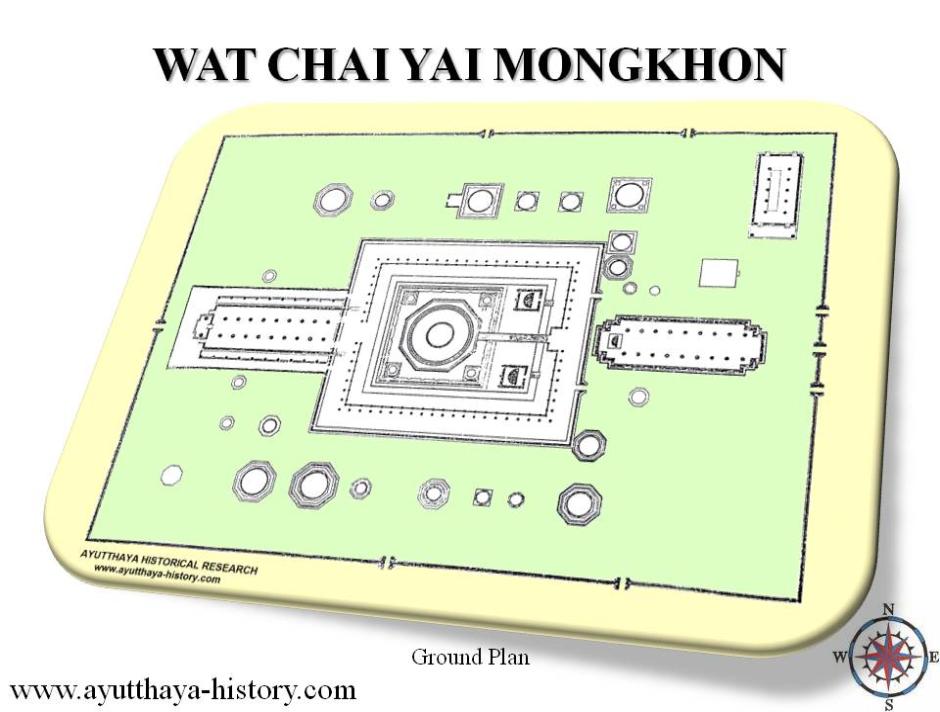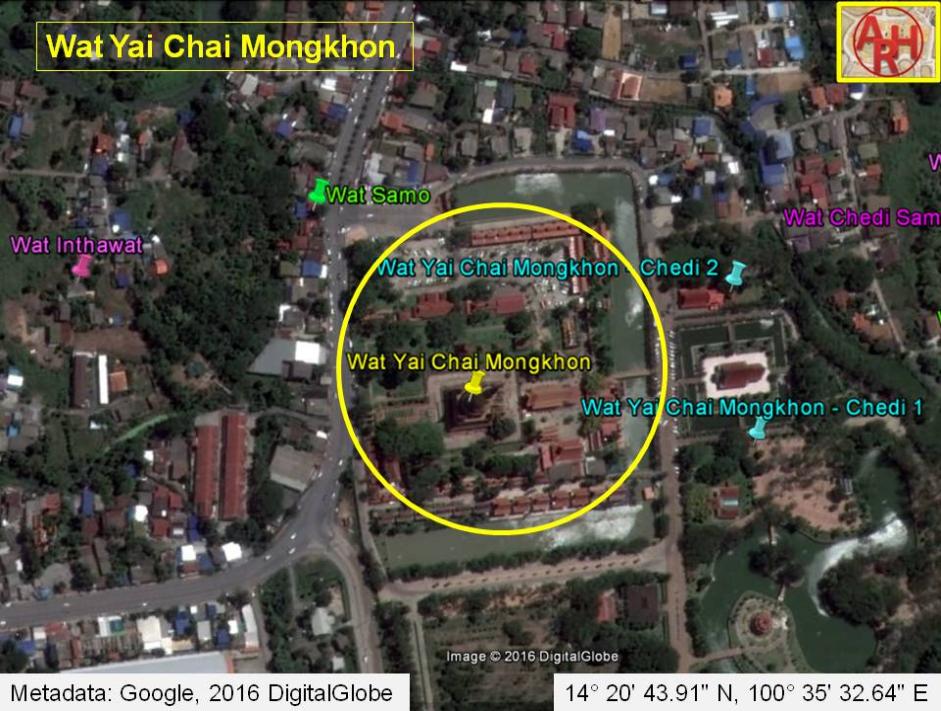| WAT YAI CHAI MONGKHON (วัดใหญ่ชัยมงคล) |
| Wat Yai Chai Mongkhon or the Great Monastery of Auspicious Victory is located off the city island in the southeastern area of Ayutthaya in present Phai Ling Sub-district. In the past it bears other names as Wat Pa Kaeo, Wat Chao Phraya Thai and Wat Yai Chaiya Mongkhon. The easiest way to reach this active monastery is by turning south at the roundabout chedi on Rojana Road (Wat Sam Plum) along road No 3059. The temple can be easily found at the eastern side of the road. Wat Yai Chai Mongkhon is situated in a part of the ancient city known as Ayodhya. It is widely believed that a Dvaravati (and Lopburi allied) settlement existed here before King U-Thong established Ayutthaya in 1351. There are indications that the site was surrounded by a large moat in earlier times. The monastery was accessed before by Khlong (Pak) Khao San, which got its mouth at the new Pa Sak River. There are also traces of an ancient canal east and west of the temple; the latter ran, parallel with Khlong Khao San, also towards the Pa Sak River. There are seemingly traces from an ancient baray or water reservoir, close to the southwestern tip of the monastery. It could thus be that Wat Yai Chai Mongkhon has been built on a former important Khmer temple complex - taken also in account the large moat which represented for the Khmer, the oceans that surround the world. (1) Historical background In the year 1357 two princes of Ayutthaya, Chao Kaeo and Chao Thai, died of cholera. King Ramathibodhi I (r. 1350 - 1369) ordered the bodies of both princes to be exhumed and at the cremation site, a monastery with a holy monument (stupa) and a preaching hall (viharn), be established. He gave the monastery the name "Wat Pa Kaeo" or the Monastery of the Crystal Forest. (2) [1] The temple became the home of Buddhist monks ordained and trained at the Monastery of Phra Wanaratanathen in Ceylon (present Sri Lanka). The Sangha group was mainly engaged in meditation. The king conferred the title of "Right side Supreme Patriarch" to the head of the group, Somdet Phra Wanarat. The monastery became known as “Wat Chao Phya Thai” - The Monastery of the Supreme Patriarch. [2] This temple was repeatedly involved in the history of Ayutthaya. It was here that the conspirators (Khun Inthorathep, Mün Ratchasaneh, Luang Si Yot, Phirenthorathep and Prince Tianracha), end 1548 gathered in the preaching hall to burn candles to consult an oracle whether or not to overthrown the throne usurper Khun Worawongsa and Queen Thao Sri Sudachan; which resulted in Prince Tienracha becoming king in on 19 January 1549, crowned with the title King Maha Chakkraphat (r.1548-1569). [1] In 1561 the Patriarch of this monastery fixed the auspicious moment for Prince Sri Sin, the youngest son of the previous King Chairacha (r. 1534-1547) and Queen Thao Sri Sudachan, to overthrown King Maha Chakkraphat. Prince Sri Sin although was captured during the rebellion and died in the palace, while the Patriarch was executed for his involvement. [3] In 1592 King Naresuan (r. 1590-1605) defeated the Burmese Army at Nong Sarai by killing the Burmese Crown Prince in single-handed combat on elephant. In the battle the King and his brother King Ekathotsarot got separated from their army officers. On return to Ayutthaya the King wanted to punish to death his officers, but the Supreme Patriarch intervened and requested the punishment to be suspended; which King Naresuan granted. The Royal Chronicles of Ayutthaya although, state nothing about the construction of the great chedi. It is assumed that, on this occasion, King Naresuan ordered the restoration and enlargement of the temple and the principal chedi. The chedi was named Phra Chedi Chaiya Mongkhon. Presumably this celebration gave rise to the temple’s new name, Wat Yai Chaiya Mongkhon - The Great Temple of Auspicious Victory. Wat Yai Chai Mongkhon turns also up in western documents. In the "Diary of the Picnic incident" Van Vliet recalls that "he sent a messenger to the Abbot of Thimpiatti to request his intercession with the King, partly because this priest is a good friend of mine, who is favorably disposed towards our nation, and in part also because the merciful intercession of the Religious is freely permitted in this Kingdom". This priest was described by Van Vliet as very powerful. He needed the head monk to help him out, as some Dutch went on drunken rampage and had created problems. [4] Jeremias Van Vliet gives us also some ecclesiastical information and wrote "within the jurisdiction of Judia are the four principal temples of the whole country; namely the king's temple, Wat Syserpudt, the Nappetat, Wat Deun (which temple is devoted to the moon and where the highest school is established), and Thimphiathey." [5] Hence the importance of the help of the head monk, high in the Sangkha hierarchy, in the paragraph above. Van Vliet also wrote that the people told him: "In the pointed tower Thimphiathey there is a costly ruby, the value of which can hardly be estimated; and in order that nobody may take the buried riches from the gods, there are many dead guards placed there." His story seems to take suddenly the path of horror, when he continues: "This is to be explained in the following manner. If any mandarin - he may rich or poor - has the intention to make an offering of a human body to temple or to the gods, he chooses one or more of the most faithful, most able, and most capable men amongst his slaves. He treats this slave like his own child and shows him much friendship. By this the slave becomes attached to his master that he cannot refuse any request. And when the day has come that the treasures will be offered, the master tells this to his slave and asks him to be the guard of the offerings. The slave has been won so strongly by the honor which he has enjoyed, that he accepts the proposition voluntarily. He is then cut into two pieces at once, thrown into a pit and the money is placed on his dead body. The spirit of the killed person goes into a terrible monster, who has the power to guard the offerings so that they cannot be stolen by anybody." [6] The Phraya of Tak (the later King Taksin) was promoted to Phraya Kamphaeng Phet by the Siamese King Suriyamin (Ekathat) and appointed as a brigade commander of a boat army that he had to constitute at this monastery in order to confront the Burmese in the open plains southeast of Ayutthaya end 1766. [6] In 1767 the temple was sacked by the Burmese and the premises deserted. The monastery was re-established and officially recognized in 1957. Wihan Phra Phuttha Saiyat or the Vihara of the Reclining Buddha was constructed during the reign of King Naresuan. The new image was remodeled in 1965 after the original got ruined by fortune hunters. The statue lies in a north-south position, with its head in southern direction and facing the east. In 1979 the abbot, Phra Pawanarangsi, in coordination with the Fine Arts Department constructed a new ordination hall on the old remains, maintaining partly the ancient site, so that the original structure remains visible. Architecture The chedi of Wat Yai Chai Mongkhon is one of the landmarks of Ayutthaya, standing high, and visible to all, who approach the city from the east, at par with Chedi Phukhao Thong. The bell-shaped principal chedi stands on an elevated square base with smaller chedis at the corners. There is a second octagonal pedestal above the base to accommodate the bell-shaped body. Stairs lead up on the east side towards the first terrace, and continue inwards the dome. Inside the dome we can see the chamber where the relics were contained. Two mondops stand in the front, with their pyramidal upper structures collapsed, exposing the Buddha statues inside. A rectangular gallery encircles the principal chedi. The gallery is enclosed by an outer wall, which along with the pillars inside, supported before the roof. Presently only the foundations of the pillars can be seen. The floor of the terrace is as usual one step higher than the court. Along the inner wall of the gallery are rows of (newly sculpted) Buddha images on decorated bases. These rows of Buddha statues are newly sculpted in order to replace those which collapsed through the time. The statues are all identical and before gilded. The bases contain the ashes of the death. West of the chedi are the remains of a sermon hall. The whole temple complex is surrounded by an outer wall. The ordination hall or ubosot lies east and in the front of the large chedi. The hall measures 16 m by 44 m and has been re-roofed to preserve it from further damage. If I recall well it was before partial surrounded by a moat (which now has been filled). Phra Phuttha Chaiya Mongkhon in the ordination hall is one of the most sacred Buddha images in Ayutthaya. At the western side of the great chedi was a large vihara measuring 15 m by 39 m, nearly extending towards the outer boundary wall. In the area around the monastic structures we see more than twenty satellite chedis of various sizes which contain the ashes of former sponsors of this temple. The area of the monastery has been extended towards the east. A viharn has been built to honor King Naresuan. The present entrance is situated between the monastery and the monk’s living quarters at the northern side. We can find the location back of Wat Yai Chai Mongkhon on two old maps. The map made by de Graaff indicates the temple as "Tianpiatay", while Engelbert Kaempfer indicates it on his map drawn in 1690 as "Tiampiatay". Wat Yai Chai Mongkhon is located in geographical coordinates: 14° 20' 43.91" N, 100° 35' 32.64" E. Footnotes: (1) The Khmer temple complex was designed as an earthly model of Mount Meru, home of the Hindu god Vishnu. Mount Meru’s five peaks are conceived as surrounded by mountain ranges and oceans, represented architecturally by the outer walls and moats. A Sanskrit inscription compares the moats and reservoirs at the temples with tributaries of the sacred Ganges River in India. (2) Luang Prasoet’s "Royal Chronicles of Ayutthaya" set its establishment at 1363 AD. |

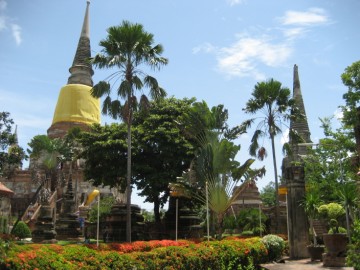
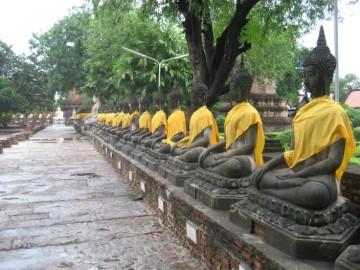
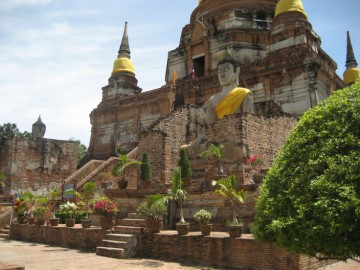

| References: [1] The Royal Chronicles of Ayutthaya - Richard D. Cushman (2006) - pages 23-24 / Source: Phan Canthanumat, British Museum, Reverend Phonnarat, Phra Cakkraphatdiphong & Royal Autograph.page. [2] Ayutthaya: A World Heritage - TAT (2000). [3] The Royal Chronicles of Ayutthaya – Richard D. Cushman (2006) - page 31 / Source: Luang Prasoet. The Royal Chronicles of Ayutthaya – Richard D. Cushman (2006) - page 42 / Source: Phan Canthanumat, British Museum, Reverend Phonnarat, Phra Cakkraphatdiphong & Royal Autograph.page. [4] Van Vliet's Siam - Chris Baker, Dhiravat Na Pombejra, Alfons Van Der Kraan & David K. Wyatt (2005) – page 54. [5] Van Vliet's Siam - Chris Baker, Dhiravat Na Pombejra, Alfons Van Der Kraan & David K. Wyatt (2005) – pages 155-156. [6] The Royal Chronicles of Ayutthaya - Richard D. Cushman - Page 512-514 / Source: Phan Canthanumat, British Museum, Reverend Phonnarat & Royal Autograph. |
| Text, maps & photographs by Tricky Vandenberg Updated March 2016 |
| (View from the north-east) |
| (Main chedi) |
| (View from the elevated base) |
| (The former gallery) |
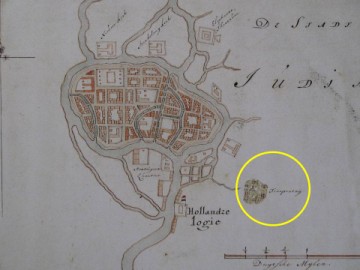
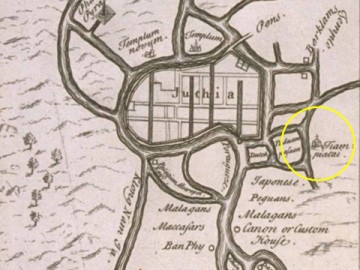
| (Map of Engelbert de Graaff - c.1690) |
| (Map of Engelbert Kaempfer - 1690) |

| (Click the button to see the ground plan) |
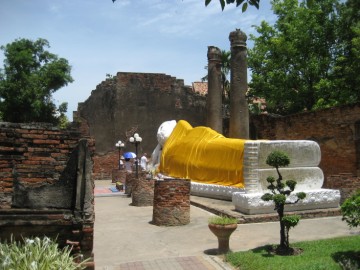
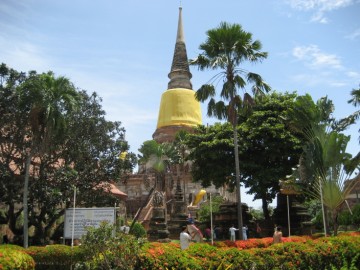

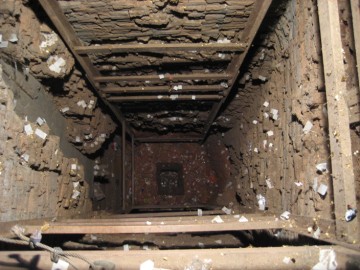
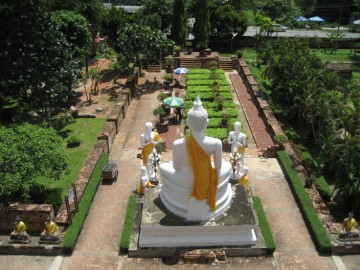
| (The ordination hall or ubosot) |
| (The reliquary chamber inside the main chedi) |
| (View on the remains of the vihara) |
| (Vihara of the Reclining Buddha) |
| (Principal chedi) |
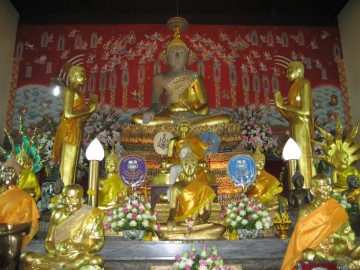
| (Phra Phuttha Chaiya Mongkhon) |
